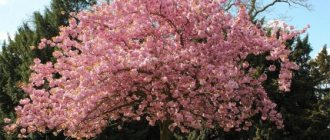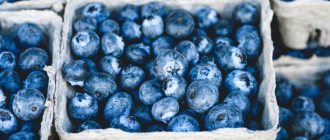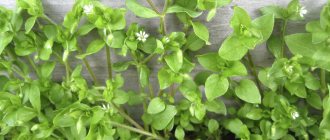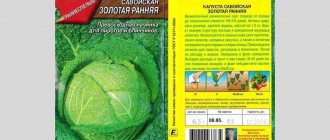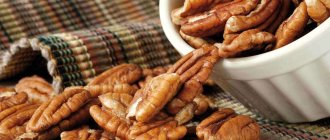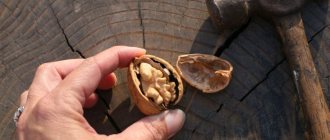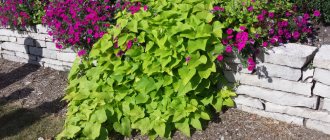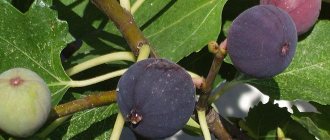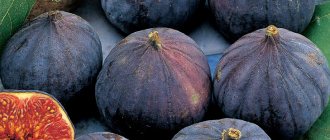general information
Figs have been known to man since ancient times and have been cultivated for approximately five thousand years. Under favorable conditions, this tree grows and bears fruit for more than three centuries. The fruits, filled with juice and possessing excellent taste, were valued very dearly by gourmets.
There are more than a thousand varieties of this magnificent plant. Fruits have different sizes, shapes, colors, tastes, ripening periods, and yields (some bear fruit twice a year). Fig berries are widely used in the food industry. A variety of figs has been developed that is used only for dried fruits and is not consumed fresh. The fig tree is indiscriminate in terms of growth conditions, bears fruit steadily, and is not susceptible to diseases and pests.
Fig variety Abkhazian purple
Abkhazian purple or Temri is a popular variety of fig, which stands out not for its smooth, but for its slightly ribbed surface. Like most varieties, it bears fruit twice, but quite late, because the fruits can be collected in August and November. The fruits in each fruiting season have a certain peculiarity, because the first harvest is slightly larger than the second wave, so the weight will be 80 and 50 grams, respectively. The shape of the fruit, although ribbed, is quite elongated and has an original color - purple combined with a shade of burgundy. This variety is very popular due to its excellent taste and wide range of uses.
Figs: description, varieties, photos
The most popular ones include the following:
- Crimean black. It is of European origin. When caring for the crop, be sure to prune and shape the crown. Its high yield and mid-season fruit ripening make it possible to enjoy them twice a year - in July and September. The berries of the first harvest are large, purple, pear-shaped, asymmetrical in shape, weighing up to 80 g.
At the second harvest, the fruits are half the size, have an elongated pear-shaped shape and are black in color, tinged with violet. Raspberry juicy pulp has a slight sourness. In hot weather, the fruits of this fig variety are dried in the sun.
- Dalmatian. One of the best early ripening table varieties. Two harvests are harvested per year, the fruits of the first weighing 180 g, the second - 130 g. The shape is elongated, reminiscent of a narrow pear, the skin is yellowish with white spots. The reddish flesh is sweet with a slight sourness and melts in your mouth.
- Abkhazian purple. Refers to figs, the variety of which has a medium-late ripening period. Bears fruit generously twice a year. The first harvest ripens after mid-August, its fruits weigh no more than 80 g. The berries of the second harvest, weighing no more than 50 g, ripen in early November. The fruit is brownish-violet in color with an elongated, slightly ribbed shape and is very pleasant to the taste.
Fig sabrucia rosea: description, photo – Fertility
Fig Sabrutsia Rosea is one of the types of tropical plants that can grow and bear fruit in Russia.
The variety was bred by the Nikitsky Botanical Garden and is the second most common on the Black Sea coast of the Caucasus.
If you follow the growing characteristics and properly prepare figs for winter, you can get healthy exotic fruits in your own garden in the Crimea, Kuban, and on the Black Sea coast.
Description of the fig Sabrucia Pink
Figs have many names, originating from different languages: fig, fig tree, wineberry. The fruits are sold and consumed in fresh, dried, processed form as a valuable food product and an element of traditional medicine.
Fig Sabrutsia Rosea, depending on the method of formation, can be a small tree with a columnar, cup-shaped crown or a shrub. In favorable conditions, the plant lives up to 300 years without losing its ability to bear fruit.
The strong root system of an adult Sabrucia bush penetrates to a depth of 2.5 m, while actively developing all layers of soil and requiring regular watering. Fig shoots are actively formed, which without pruning leads to thickening of the crown.
The variety is early ripening. The first wave of the harvest of pink Sabrucia figs, depending on the climate, ripens from June to August. The second fruiting occurs in late autumn. In Russia, where the climate allows cultivating fig trees in open ground, part of the unripe crop remains to winter.
The fruits of Sabrucia rosea, like all figs, are thickened shoots (syconia), resembling vessels with thick walls and juicy pulp with numerous round seeds inside.
Characteristics of the fruits of the Sabutia Pink fig:
- round or pear-shaped;
- brown peel with a reddish tint;
- soft pink juicy pulp;
- dessert taste with a predominance of sugars;
- fruit weight from 100 to 150 g.
The Sabrucia Pink variety is partially self-fertile and produces abundant harvests without pollination. Young plants begin to bear fruit 2 years after planting. The domestically selected fig variety has good frost resistance and is able to withstand cold temperatures down to -18 °C.
Pros and cons of the variety
According to the description and photo, the Sabrucia Rosea fig is an attractive fruit crop, both for single plantings and for commercial cultivation. Reviews from experienced gardeners highlight the following advantages of the variety:
- Large, beautiful fruits.
- Delicate dessert taste.
- Versatility in use.
- Transportability and keeping quality.
- Ease of vegetative propagation.
- Resistance to typical garden diseases and pests.
- Possibility of cultivation on poor, rocky soils and steep slopes.
Disadvantages of the crop include the difficulty of obtaining two harvests and the need for a heated greenhouse for growing Sabrutsia Rosea in the middle zone. Despite all its unpretentiousness, heat-loving figs require careful preparation for winter.
Growing Sabrucia Rosea
The tropical plant has several characteristics that must be observed to grow an exotic fig tree in a temperate climate.
Advice! In regions that do not provide the Sabruzia rosea fig with the necessary summer temperatures, light, or with the danger of winter freezing, home cultivation of the crop as a houseplant is practiced.
Propagation of figs by seeds is practiced by professional breeders and specialized nurseries. A varietal seedling of Sabrucia, purchased from a trusted manufacturer, takes root easily and quickly forms a dense crown.
In the process of pruning bushes, cuttings are prepared from annual shoots that take root well. It is easy to propagate Sabrutsia figs by layering or planting young root shoots. They act in a similar way to the propagation of currants.
The place for planting the Sabrucia Rosea seedling is chosen in the most illuminated place of the site. Southern slopes or places covered from the north by a small barrier (fence, wall) are preferred. The composition of the soil, its acidity and nutritional value do not play a decisive role in the survival rate of the Pink Sabrucia seedling. It is important to ensure regular moisture to the roots, without flooding or prolonged wetting of the roots.
Important! Areas with a groundwater horizon higher than 2 m are not suitable for figs. Elevations or places with drainage of excess moisture are preferred. When planting Sabrucia Rosea in regions with a lot of rainfall, special attention is paid to drainage.
The planting site is prepared in proportion to the volume of the roots of the young fig. The substrate removed from the pit is mixed with organic fertilizers and sand. Next steps for planting figs:
- The soil is poured into a heap in the center of the hole.
- Place the seedling on the mound and straighten the roots.
- Gradually add soil mixture, lightly compacting each layer.
- Water the plantings abundantly and wait until the ground settles completely.
- As a result, the root collar of the fig seedling should remain above the ground level.
- Mass plantings can be done in small trenches, which makes it easy to cover the plants for the winter.
In the middle zone, the fig Sabrucia Rosacea is planted obliquely, maintaining an angle to the ground surface of up to 40 °. Cut all stems at a height of 20 cm, leaving only a few branches. Already the second season is producing an increase in fruit-bearing shoots.
Watering and fertilizing
The unpretentiousness of figs to soil composition is manifested in subtropical and tropical latitudes. This allows trees to take root on rocks, steep cliffs and bear abundant fruit without special care. In a temperate climate, the plant requires more attention: feeding, watering, careful shaping.
The deep roots of an adult plant provide the pink fig Sabrucia with survival during droughts and save it from freezing. The upper layers of the soil also contain an extensive system of root shoots. Timely moistening of Sabrucia significantly enhances the nutrition of the fig tree and increases the yield of the crop.
Watering is carried out as necessary, making sure that the top layer of soil does not dry out completely. Figs respond well to mulching. This procedure not only retains moisture, but also ensures that the soil is kept loose.
Important! Air permeability of the soil is a special requirement of figs for cultivation.
Deep and frequent loosening around young trees is impossible without damaging the surface roots. Therefore, for Pink Sabrucia, it is recommended to mulch the tree trunk circles with loose mown grass.
Fig plantings are fertilized monthly according to the following rules:
- In spring - nitrogen and potassium-phosphorus compositions.
- During the growing season - mulching with humus with the addition of superphosphate and potassium salt.
- To enhance the formation of the ovary - foliar spraying with complex mineral compounds.
- After the first harvest, re-fertilize with nitrogen fertilizers.
The Sabrucia fig responds well to pollination with wood ash and spraying with its solutions, which is both a fertilizer and disease prevention.
Trimming
In temperate climates, Pink Sabrucia is formed in several ways:
- in the form of small trees with a cup-shaped sparse crown;
- like bushes with one or more trunks, in the likeness of grapevines;
- fan-shaped, with stems up to 2 m in height.
The fan method of forming a bush is most convenient in regions with cold winters. Such trunks are easier to tie and lay on the ground without damaging them.
The main rule for pruning Pink Sabrucia for any type of crown is to provide the fig with maximum light and ventilation. When removing all the thickening growths growing inside the crown, pay attention to the fact that the first harvest is planted on last year’s branches, and the second on fresh shoots of this season.
Basic principles for pruning figs:
- Pruning and shaping work is carried out after the leaves fall or in the spring before active sap flow begins.
- It is advisable to treat not only large-area cuts with garden varnish, but also minor damage. Fig wounds heal slowly, which can weaken the bush.
- Young branches of Sabrutia rosea, left for fruiting, are pinched when they reach 0.5 m in length. This stimulates the development of lateral productive shoots.
- To obtain a tall tree in the future, the first pruning of the fig is done at a height of 1 m; to form a compact plant, the central trunk is cut off, leaving 50 cm.
In the first years, the desired crown shape is created, removing all excess growth. In plants 3-5 years old, strong lateral shoots are shortened by a third. Thickened figs lose in yield, and good lighting promotes the formation of ovaries. Therefore, sanitary pruning is mandatory every year. Formation is not required for an adult plant of Pink Sabrucia.
Preparing for winter
Conditions of a temperate climate in the warm season are quite consistent with the requirements of the tropical Pink Sabrucia. Figs need to be prepared for frost. When carrying out pre-winter work, it is important to take into account the peculiarities of the local climate:
- If in winter subzero temperatures prevail, often falling below the critical level for Sabrucia Pink - 18 ° C, then solid shelters are prepared. They use wooden shields, roofing felt, and hill the trunks high.
- In moderate but frosty winters, it is enough to tie the fig branches together and wrap the plant in several layers of non-woven garden material. The soil in the tree trunk circle is mulched with a layer of up to 10 cm.
- The cold season with a predominance of above-zero temperatures and rare frosts does not require special conditions for wintering figs. It is enough to wrap the plant with breathable garden material. A thoroughly sheltered plant in such a climate can completely dry out.
Attention! Polyethylene, foam plastic, and other airtight materials are not used to prepare figs for winter. During a prolonged thaw, such shelter becomes more dangerous for the plant than frost. Figs may die out or get fungal infections.
Shelter of Sabrucia Pink from frost:
- carefully bend the branches to the ground and pin them;
- lay plant material (leaves, pine needles, sawdust);
- cover the top with a layer of earth about 15 cm;
- arrange shelter using breathable material or wooden shields.
Before arranging Pink Sabrucia for the winter, all trunks are treated with lime or a solution of copper sulfate (1%). Spray the trench and covering mass with the same composition.
Harvesting
Sabrucia Pink is a fig variety with medium-early fruit ripening. The first figs are removed from the bushes 80 days after the start of the growing season. When optimal conditions are created, figs are capable of bearing fruit twice a year. The first harvest of Pink Sabrucia is harvested from June to August, the second wave can begin in August, September and last until persistent cold weather.
The fruiting period of Sabrucia Rosea is extended and ranges from 30 to 60 days. Ripe figs are collected regularly, once every few days. It can be difficult for an inexperienced gardener to determine the ripeness of fruits and collect them on time.
Signs of a ripe Sabrucia fig:
- The figs doubled in size.
- The color of the figs became rich and bright.
- Small drops of nectar appeared on the peel.
It is important to remove the ripe fruits of Sabrucia rosea in time - after 3 days they begin to wilt. The shelf life of overripe figs is significantly reduced. The fruits dried on the branches are collected to make dried fruits.
Diseases and pests
Just a few years ago, fig plantings in temperate climates did not suffer from any diseases; local pests did not pay attention to them. Preventive treatments of Pink Sabrucia were carried out together with other garden crops and traditional means (for example, solutions of copper sulfate).
As figs adapted to local conditions, gardeners began to note cases of Sabrucia rosea being damaged by insects and some diseases.
The following infections and pests can cause harm to the plant:
- coral spotting is a fungal infection;
- bacteriosis – infection with various dangerous bacteria;
- white leafhopper, aphid, spider mite.
At the first signs of disease, figs should be treated with fungicides, insecticides or complex chemicals, respectively. All affected parts of plants are carefully removed from the bushes and burned outside the site.
Conclusion
The Sabrucia Rosea fig is a good example of adapting a valuable tropical plant to cold winter conditions.
Thanks to the work of domestic breeders, tasty and healthy fruits can be grown in a variety of conditions.
Sabrucia Rosea today can be seen along the entire Black Sea coast of Russia, in Crimea, Kuban, and in the Caucasus Mountains. The fig variety is spreading further north, where it is cultivated as a greenhouse and hothouse crop.
Source: https://kfxvorobievsp.ru/sorta/inzhir-sabrutsiya-rozovaya-opisanie-foto.html
Frost-resistant
Figs, varieties of which can grow at temperatures down to -27 degrees, are grown in gardens and household plots as a decorative or fruit crop. Winter-hardy include:
- Brunswick. It is famous for its early ripening of very large fruits. Their weight reaches approximately 200 g. The shape of the berry is pear-shaped, the color is greenish with a purple tint. The juicy sugar pulp has wonderful taste qualities. Fruits twice a year. Multi-purpose application.
- Kadota. Medium-late ripening, harvested twice a year. The weight of the fruit of the first harvest is 70 g and 60 g of the second. The fruit is round in the shape of a pear, with a rather dense peel of a yellowish tint with a green tint. The rich, appetizing, pinkish-red flesh has an attractive taste. Figs of the Kadota variety are not damaged during transportation. Used in industrial and domestic conditions for the production of jams and preserves.
Large-fruited
They have advantages over others due to their large and tasty fruits. The largest fruits include:
- San Pedro is black. It was bred in Spain and gained its popularity all over the world; the fruits are shaped like a beveled egg up to 10 cm in diameter, pleasant to the taste. The berries grow on vigorous fig trees that require care and good fertile soil. Under ideal conditions, the fig tree produces a rich harvest twice a year. The fruits have aromatic, sweet pink flesh and almost black skin. Consumed fresh, dried or processed.
- Corderia. The berries of this variety of figs (photo below) are large, covered with a yellowish-green skin and contain orange, very sweet pulp of excellent taste.
Corderia perfectly withstands moisture deficiency in the soil, so it is preferred to grow it in waterless areas.
- Sugar Celeste. Frost-resistant variety with large berries and two harvests per season. The fruit is sweet and juicy, pear-shaped with a thin greenish skin with a purple tint.
Rules of care
Caring for figs of any variety is not difficult, since the plant is extremely unpretentious. In the south of the country it bears fruit well with minimal care. In temperate climates, for the full development of the Sabrucia rosea variety, it is necessary to regularly trim the figs and feed them from time to time.
Watering
The frequency of watering is determined by the appearance of the soil in the area of the fig tree trunk - the top layer of soil should not dry out or crack. Young plants are watered on average once a week, with about 5-8 liters of water per bush or tree. Adult figs are watered a little less often - once every 2 weeks, however, water consumption increases to 10 liters per plant. When the figs begin to form fruits, the plant should not be watered. Irrigation is resumed after harvest to increase the wear resistance of the crop.
Advice! It is recommended to combine soil moistening with weeding and loosening. It’s easier to pull weeds out of the soil when it’s softened, and loosening helps saturate the plant’s root system with oxygen.
The variety Sabrucia rosea responds well to mulching the tree trunk. Covering the soil promotes better moisture retention and maintains soil looseness. Grass clippings and fallen leaves are usually used as mulch.
Top dressing
Feed figs of the Sabrucia rosea variety in this way:
- In spring, nitrogen, potassium and phosphorus fertilizers are applied to the soil.
- During the growing season, the tree trunk circle of the plant is mulched with humus, which is pre-mixed with superphosphate and potassium salt.
- When the figs begin to form ovaries, the soil is fertilized with complex mineral compounds.
- After harvesting, re-fertilize with nitrogen.
The frequency of feeding is 3-4 weeks. The variety Sabrucia rosea responds especially well to fertilization with wood ash, which can be used in the form of a powder or solution. In the second case, the substance acts not only as a supplement, but also as a prophylactic against a number of diseases.
Important! Fig Sabrutsia rosea is fed after watering. Otherwise, there is a high probability of causing numerous burns to the plant’s root system.
Trimming
In Russia, figs of the Sabrucia rosea variety are formed in one of the following ways:
- in the form of a small tree with a cup-shaped crown;
- in the form of a bush with one or several trunks, like a grapevine;
- in the form of a fan-shaped shrub.
The latter option is especially convenient when growing in a region with cold winters. Figs shaped like a fan are easier to place on the ground in the fall.
Plantings of the Sabrucia rosea variety are pruned taking into account the following rules:
- All work is carried out in the fall, after the plant sheds its leaves, or in the spring before sap flow begins.
- Cuts and minor damage are smeared with garden varnish.
- Young fruitful shoots are pinched to 40-50 cm in order to stimulate the growth of lateral branches.
- A tall tree can be obtained if the first pruning is done at a height of 1 m. To obtain a shrub, the plant is cut to 50 cm.
- The first 2-3 years of a fig’s life focus on crown formation. At this time, it is determined whether the plant will be a bush or a tree.
- Figs that are about 4-5 years old are shortened by 1/3.
Adult figs are not pruned, except for sanitary cleaning of diseased and damaged shoots. They also return to pruning if the plant’s branches thicken. In this form, the variety Sabrucia rosea will bear fruit much worse.
Preparing for winter
The variety Sabrucia rosea is not able to survive winter frosts on its own, so in the fall the plant is covered. The degree of preparation for wintering depends on local climatic conditions - if the temperature in a given area drops below -18°C in the winter months, then the figs are insulated most fully:
- The trunk of the plant is spud high;
- the branches are neatly tied together;
- the top of the bush or tree is covered with roofing felt;
- The installation of wooden panels completes the preparation.
When growing in areas where frosts are moderate in winter, it is enough to simply tie the fig shoots and wrap the plant with roofing material. Additionally, the soil around the trunk is mulched to a depth of 10 cm. Sawdust, dry leaves and pine needles are used as mulch.
If the temperature in the area is positive even in winter, then you can completely limit yourself to light covering material. In this case, strong insulation will only do harm, since the figs can completely dry out under it.
Regardless of the degree of preparation, it is recommended to treat the plant trunk with lime or copper sulfate solution.
The sweetest
Strawberry. The variety is distinguished by tall, strong trees and good cold resistance. Plants have good productivity. Their pear-shaped fruits with a refined taste, sweet, fragrant medium-sized pulp ripen after August 15. Used in fresh and processed form.
Honey. Mid-season, does not require pollination, the trees are heat-loving, low-growing, spreading, do not need highly fertile soils. The fruits are light green in color and unusually sweet. The tree is suitable for growing at home.
Mid-late varieties
Temri. It grows in the Caucasus, and its homeland is Tunisia. The plant is self-fertile, very productive, the fruits begin to ripen at the end of August, fruiting ends in November. The berries are sweet, ovoid, slightly ribbed, covered with burgundy-purple skin, weighing up to 75 g.
Date Neapolitan. It bears fruit once a season in September. The fruits are pear-shaped, medium in size and have good taste, the pulp is raspberry-colored, the skin is burgundy with a purple tint.
Pink fig tree
The fig variety Sabrucia rosea bears fruit without pollination, is a winter-hardy tree, can withstand frosts down to -18 degrees, and produces two harvests per season. The first is called winter because the ovary forms in the fall and, with good shelter, is perfectly preserved until the spring warmth. In July these fruits ripen. And at the very beginning of June, in place of the new growth, a second harvest is formed, the fruits of which ripen in September.
Large berries with a diameter of 5 to 6 cm and a length of up to 10 cm have a pear shape and excellent taste. The skin is grayish-pink in color, and the flesh is the color of strawberries. A fully ripened fig fruit is sweet and aromatic. The tree should be grown in trenches and covered with insulation for the winter in order to obtain a July harvest. For the autumn harvest, it is enough to cover the base with soil, pull it together and wrap the tree with material. Berries picked after drying have a rich aroma and are very sweet, while berries picked after yellowing of the peel are less fragrant and of moderate sweetness, but are stored longer.
Growing rules
Fig Sabrucia Rosea is a rather unpretentious plant. The variety is undemanding to the type and quality of soil and is able to bear fruit well even in sparse rocky areas. The only essential requirement is a warm, mild climate in the growing region. If climatic conditions do not allow figs to be left overwintering in the open ground, the plant is grown in special tubs, which are put indoors for the winter.
Recommended timing
You can plant figs of the Sabrucia rosea variety in both spring and autumn. In the first case, planting is carried out in early April. In autumn, figs are planted in September - early October, however, at this time planting is possible only in the south of the country. In the conditions of central Russia, it is better to plant the variety in the spring.
If the planting material has a closed root system, the planting dates are shifted to the second half of May - so, by autumn the plant will have formed a full-fledged root system and 2-3 skeletal branches.
Site selection and soil preparation
The seedling receives full development on a site that meets the following criteria:
- the place should be open and well lit;
- preference should be given to hills and southern slopes;
- from the north, the plant should be protected from strong winds by a house wall or fence;
- The groundwater level should not be higher than 2 m.
The fig variety Sabrucia rosea does not make any special demands on the soil: neither the acidity nor the fertility of the site matters. The main thing is to regularly moisten the soil without flooding the plantings. Excessive soil moisture can cause fig root rot.
Advice! On loamy soil, drainage must be placed at the bottom of the planting hole. Sand or small crushed stone is suitable for these purposes.
How to plant correctly
Planting of figs of the Sabrucia rosea variety is carried out according to the following scheme:
- In the selected area, dig a planting hole or trench if you plan to plant several plants. The dimensions of the pit are determined taking into account the root system of the seedlings.
- A drainage layer is placed at the bottom of the planting hole if the figs are planted on heavy loamy soils. Drainage is also necessary if the region experiences frequent heavy rains.
- A soil mixture of the following composition is placed on top of the drainage: the top layer of soil from the site, fine-grained sand and humus or manure. Such a substrate will provide the plant with sufficient nutrition for full development for several months without additional feeding.
- A seedling is placed on a mound of the resulting soil mixture and its roots are evenly straightened along the slopes.
- Then the root system of the fig is sprinkled with the top layer of soil from the garden plot and the area near the trunk is lightly compacted.
- Complete planting with abundant watering. When the ground settles a little, it is necessary to inspect the seedling. The root collar of the fig should rise several centimeters above the ground level. If it is hidden underground, excess soil is removed.
Important! In central Russia, the Sabrucia rosea variety is planted at an angle of 40°C. In this case, it is necessary to cut all shoots to a height of 20-25 cm. Only a few of the strongest branches are left untouched.
Figs: description and reviews
Varieties that are relatively resistant to frost include:
- Sochi 7. Good yield, fruit weight reaches 50 g, the berries have a pleasant, slightly sour taste.
- Nikitsky. The plant is partially self-fertile, mid-ripening, the fruits are sweet and sour, large.
- Dalmatian. One of the best table varieties (description above).
The most problems arise when growing figs in winter. The main task is to preserve the trees and prevent them from freezing, so amateur gardeners most often share their experience in preparing frost-resistant fig varieties for winter. In their reviews they recommend:
- plant the plant in places protected from the wind and form it correctly;
- before the onset of winter, the soil in the root part of the plant should be dry, and the roots themselves should be moist;
- Make the shelter breathable so that fungal diseases do not appear, and during thaws there is ventilation.
Caring for figs at home
Figs, Ficus carica, are quite unpretentious; to grow them at home, you need to purchase a self-fertile variety and create the necessary conditions. The optimal place for figs all year round is a glazed loggia (it is not necessary to insulate).
Figs come from the subtropics and need winter rest. In autumn, a cool room with a temperature from +1 to +10 0 C is required. Usually the fig sheds its leaves on its own, but if this does not happen, it is necessary to stop watering and dry the earth a little. For a plant without leaves, a dark room (basement or cellar) is also suitable for wintering. Watering in the winter months is limited, but the coma should not be allowed to dry out completely.
The fig rests in the room for about two months, usually November-December. On a cool balcony, the plant begins to wake up in February-March.
Figs are not very demanding on nutrition and soil quality; the best feeding for them will be direct rays of the sun.
Figs tolerate short-term dryness of the coma, but during a long drought they shed their leaves.
Figs are easily propagated by semi-lignified cuttings in spring and summer; the cuttings are planted in the ground, rooting occurs in 2 to 4 weeks. A young plant grown from a cutting can bear fruit in its second year.
Figs are affected by mealybugs, scale insects, whiteflies, aphids, and spider mites. The usual protection measures are required as for other plants.
White Adriatic fig - small but bold
White Adriatic is considered self-fertile and does not require additional pollination
This variety is common in many countries. It gained popularity thanks to the Nikitsky Garden, which intensively cultivated it from the 30s to the 60s. He also distributed seedlings and donated them to various scientific institutions. It is also known as Sochi. Well suited for growing in open ground using advanced technologies.
White Adriatic is considered self-fertile and does not require additional pollination, but with its presence the quality and quantity of fruits increases. Fruiting - 2 times a year. The fruits are small, up to 60g, oval in shape with a flat top. The flesh is pink, very sweet, the skin of the fruit is yellow-green.
Video about figs
A feature of this variety is resistance to gray rot, good preservation for a long time, and all this is due to the thick skin.
Experience of wintering figs in the garden
Unfortunately, there are no varieties of figs that could withstand thirty-degree frosts near Moscow without shelter. Therefore, in our region, figs are usually grown in an apartment, in a winter garden, in a greenhouse or in a greenhouse. In the spring, the plant is buried in the garden directly with the pot, and in the fall it is dug up and brought into a frost-free basement for the winter; Figs overwinter normally in the house, and then actively set fruit.
The temperature in the basement should not fall below –5°C: the pot will freeze, and the root system of the fig is more vulnerable than the above-ground part.
Having experience in growing figs both in greenhouses and in containers, at some point I began to leave them to overwinter in open ground. Some gardeners bend the figs into a trench, place a wooden shield or slate sheet on top and cover it with earth. This method is not very reliable: our winters are damp, the risk of wood dampening increases, and this is not beneficial for the plant.
Winter shelter for figs in the garden should be very warm!
House for figs in a garden near Moscow
For wintering, a rectangular box is made from expanded polystyrene or polystyrene foam, 1 m long, about 0.5 m wide and high. The thickness of the walls should be at least 10 cm (you can glue 2 sheets 5 cm thick together). The box is wrapped with tape several times. You need to put something heavy on top, for example, an old window frame, so that the box does not blow away and crush the roof with snow.
In winter, the structure is additionally covered with snow.
When to remove cover from figs?
In May, when the threat of frost has passed, you can completely remove the shelter. But it is not necessary to disassemble it; instead of the top cover in April, you can put a sheet of cellular polycarbonate or simply stretch plastic film, building a mini-greenhouse.
You need to leave a small gap for ventilation to avoid overheating. Figs begin to vegetate at an average daily temperature of +7...+9°C, the optimal temperature for fruit ripening is +20...+35°C.
Dalmatian is the best variety for table use
Variety Dalmatian or Turkish white. It is one of the best early ripening table varieties. It is self-fertile and bears fruit twice a season. Its peculiarity is that at the first harvest the fruits reach a very large size - up to 180g. The trees produce a rich harvest after three years.
The plant can easily withstand temperatures ranging from 0 to -15 C. Therefore, Dalmatian figs can be called frost-resistant. The fruits are pear-shaped, the skin is gray-green, the flesh is reddish, juicy, sweet with a slight sourness. In terms of taste, it is considered the best.
Did you know that among all dried fruits the first place in fiber content belongs to figs? Therefore, it is recommended for use to normalize the functioning of the gastrointestinal tract. In addition, this unique fruit contains a lot of potassium, which is good for hearts. And the rich enzyme composition allows you to normalize the functioning of the liver, stomach and kidneys. In terms of iron and calcium content, amazing figs are also significantly superior to other fruits and are recommended for nutrition in case of iron deficiency anemia and for patients during the recovery period after operations and injuries.
The plant can withstand temperatures ranging from 0 to -15 C
Kadota figs are good for preparations
This self-pollinating variety has gained particular popularity in California. Later it spread to many countries around the world. Refers to self-fertile and early-fertile varieties. The fruits reach a weight of 60g. The shape of the fruit is pear-shaped, slightly rounded, light green in color. The fruit pulp is bright pink, juicy, sweet. The variety is easily transported over long distances.
The fruits tend to wilt directly on the tree and are good for jam, jam and drying.
Did you know that regular consumption of figs paralyzes the proliferation of cancer cells and promotes retinal regeneration? But it is not recommended for diabetics, patients with metabolic disorders and obesity, because the fruit has a high sugar content.
Crimean black - unpretentious and high-yielding
Scientists at the Nikitsky Botanical Garden distinguish the variety from other specimens by its European origin. Refers to early-fertile and self-fertile varieties. Crimean black figs produce crops twice a year. When caring for trees, it is recommended to pay special attention to pruning and crown formation. The variety responds well to this procedure and produces a high yield every year.
When caring for trees, it is recommended to pay special attention to pruning and crown formation
The ripening time is extended. The fruits of the first harvest are medium-sized round figs. The second harvest is characterized by smaller black fruits with a purple tint. The taste of the fruit is sour, which makes the variety unique and in demand. Great for making jam and drying. Crimean black is perfect for planting in open ground covering structures.
